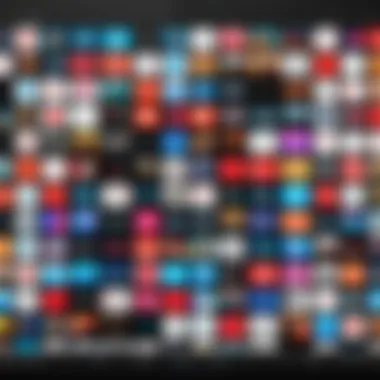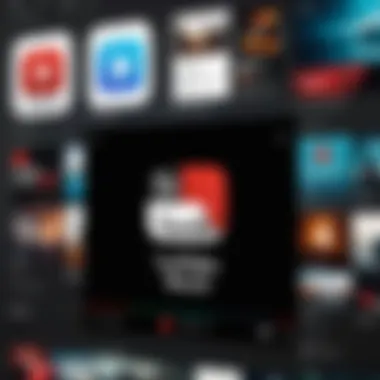Exploring Free Music Options on YouTube for Creators


Intro
In recent years, YouTube has become a vital platform for creators seeking diverse and accessible music options. Many content creators, podcasters, and even amateur filmmakers turn to YouTube for background tracks that enrich their projects while avoiding the complexities of music licensing. With the growing need for engaging yet copyright-compliant audio, it is crucial to grasp what YouTube offers in terms of free music resources.
Understanding the features available on YouTube can aid creators in making informed choices. The focus of this article will demystify the offerings, committee various platforms, and outline the limitations and possibilities associated with leveraging YouTube's free music assets.
Product Overview
Specifications
YouTube hosts an extensive library of royalty-free music via its YouTube Audio Library. This collection encompasses various genres, ensuring that users can find something that suits their project's mood. The goal is not just to provide sound but rather a specific solution for creators needing music without the overhead of licensing fees.
Design
Navigating the YouTube Audio Library is straightforward. The design emphasizes user accessibility. Search filters and categories allow users to search tracks by genre, mood, instrument, or duration. Moreover, the interface itself encourages exploration, fostering creativity and enabling easy discovery of new audio options.
Features
Key features of YouTube's free music offering include:
- Extensive Library: Thousands of tracks and sound effects.
- Search Filters: Sort music based on genres, moods, and instrument types.
- Royalty-Free Licensing: Many tracks are free to use without copyright restrictions, whereas some require attribution.
- Curated Playlists: Collections that highlight trending or recommended tracks.
- Usage Stats: Insights into which tracks are used widely.
Pricing
Utilizing music from the YouTube Audio Library is free. However, if a creator opts for additional features or specific tracks that require attribution, knowing the proper usage rights becomes necessary for compliance. Overall, for creators on a budget, these offerings are cost-effective solutions for obtaining high-quality music.
Performance and User Experience
Speed
Searching for tracks can be conducted swiftly, with stable loading times despite the extensive library. A consistent connection generally ensures an efficient experience when exploring the options.
User Interface
The user interface is intuitive. Track previews allow users to listen before integrating any music into their projects. This firsthand experience resources user control over what they choose to download and use.
Customization Options
While directly customizing tracks is limited, the search capabilities act as a means of personalizing the experience. Choosing specific moods or genres can significantly shift the music landscape, catering it to fit creator needs distinctively.
Comparison with Similar Products
Key Differences
Unlike other platforms that might host merely stock music or offer restrictive user licences, YouTube's library curates easily accessible royalty-free tracks and sound effects. This could be a key driving factor for creators focused on originality without dealing with explicit fees or permissions for each track.
Value for Money
Given that the service is free and perxtampt allowances for varying extensive composition types, its value to music-centered projects is undeniably significant. This serves especially beneficial for users early in their creative journeys.
“The YouTube Audio Library democratizes access to music for creators, setting up a landscape of innovation on a budget.”
Expert Recommendations
Best Use Cases
YouTube music offerings fit well within vlogs, educational videos, multimedia presentations, or background scoring for personal projects where creativity takes the front seat and compliance remains vital.
Target Audience
The resources cater primarily to new creators wanting to hone their craft without fear of copyright infringement. However, established content creators seeking alternative sounds also benefit greatly.
Final Verdict
In summary, the abundances present within the YouTube Audio Library empower creators to expand their artistic horizons while adhering to the necessary legal frameworks. Navigating these music options enhances online engagement while establishing characteristics integral to appealing content.
Preface to YouTube Music
In a digital landscape where music consumption is heavily intertwined with visual content, YouTube stands out as a pivotal platform. It has fundamentally shifted how artists share their works and how listeners find and appreciate music. Understanding YouTube as a music platform offers insights into its diverse offerings, accessibility, and potential for both amateur creators and industry professionals.
Defining YouTube as a Music Platform
YouTube began primarily as a video-sharing platform; however, it has evolved into a global music repository. Users can discover everything from popular hits to obscure independent tracks. This transformation has positioned YouTube as both a discovery tool and a place for artists to reach wider audiences without a traditional music label infrastructure. With billions of videos available, the platform allows users to engage with artists, comment, and participate in creating musical relevance, thus fostering a sense of community around music.


Key Features of YouTube as a Music Platform:
- Extensive Library: YouTube boasts a catalog large enough to satisfy almost any musical taste.
- User Interaction: Users can comment, like and share tracks, which enhances discovery.
- Streaming Service: Recently, YouTube has expanded to offer dedicated music features, like YouTube Music, providing curated playlists and personalized recommendations.
Being part of a broader ecosystem also allows interplay with social media, where music can thrive on platforms like Facebook and Instagram.
Overview of Music Accessibility on YouTube
Music accessibility on YouTube directly impacts consumers and creators. For listeners, this accessibility means they can instantaneously explore tracks in just a few clicks. For content creators, it opens pathways to free music options while also presenting challenges regarding copyright. The vast choice of available tracks encourages creativity but requires prudence in selection.
Factors Enhancing Accessibility:
- Free Access: Many tracks are available without cost, allowing anyone to create and share content effortlessly.
- Varied Genres: There is a wide varity of genres, making diversity in music easily accessible.
- Playlists and Recommendations: YouTube's algorithms suggest new music based on listening habits, making it simpler to find tracks that fit preferences.
YouTube’s commitment to expanding its library ensures that it will remain central to the modern music experience. However, it's crucial for anyone utilizing the platform to understand the equilibrum between accessibility and the responsibilities that come with it.
Understanding Free Music on YouTube
Understanding the concept of free music on YouTube is vital for creators who seek to enrich their projects with audio while managing budgets. Music has potential to transform dull visuals into engaging experiences. When using music freely and legal, creators add emotional layers to their content. Additionally, knowledge of this subject area opens pathways that could improve searchability and visibility within the competitive landscape of digital content creation.
What Qualifies as Free Music?
Free music commonly denotes music that anyone can access without paying royalties under certain conditions. Typically, this means that using the music does not require a direct fee, although it might still demand adherence to rules associated with reuse. The most prevalent categories of free music include:
- Public Domain Music: All rights have expired, and the work is free from restrictions.
- Creative Commons Music: Creators issue specific licenses that allow others to use their music with some obligations. Each style of Creative Commons license corresponds to different use cases.
- YouTube Audio Library: A curated collection of music intended for creators, allowing download for use in videos without charges.
Knowing how music qualifies as free allows creators to select appropriate tracks while minimizing potential legal implications.
The Role of Copyright in Music Distribution
Copyright is a legal framework that affords creators exclusive rights to their original work. This includes music. When considering free music on YouTube, the impact of copyright becomes clearer. Copyright helps producers protect their work, but it can also present hurdles in distribution. Creators must navigate various copyright rules to avoid infringing upon other artists' rights.
Key aspects of copyright include:
- Exclusive Rights: Only the copyright holder can authorize the use of their music.
- Licensing Agreements: Licensing is a way to allow usage legally while the original author retains rights.
- Enforcement Actions: Violating copyright can lead to penalties or removal of content.
Legal considerations should always be taken into account to ensure compliance and protect originality.
Navigating copyright is both a responsibility and necessity for anyone using music for multimedia content on YouTube. Educating oneself about the framework not only prevents legal headaches but can also forge stronger connections with legitimate musicians and composers.
Accessing Free Music on YouTube
Accessing free music on YouTube is essential for creators seeking to enhance their content without incurring costs associated with traditional music licensing. Videomakers, podcasters, and even social media influencers can benefit from the broad range of free music available, allowing them to differentiate and elevate their work. It is also necessary to navigate YouTube's offerings wisely, as not all available tracks are royalty-free or can be used without restrictions.
By understanding where to find, and how to use, this music, creators can harness a powerful tool that complements their projects. Coordination between creativity and resourcefulness pushes content to greater heights and ensures compliance with legal considerations.
Navigating YouTube's Music Library
YouTube's Music Library serves as a principal resource for free music. It hosts countless royalty-free tracks, which means users can legally use them in their content without worrying about copyright infringement. Finding the right track can depend on several factors, such as mood, genre, or instrumentation one intends to convey through their project.
To access this library, a user ought to take the following steps:
- Visit the YouTube website or app.
- Click on your account icon and navigate to YouTube Studio.
- From the menu, select the
Benefits of Using Free Music
Accessing free music through platforms like YouTube can be transformative for creators. Not only does it allow for budget-friendly options in content creation, but it also opens avenues for creative expression and audience connection. In this section, we will focus on two critical benefits of using free music: the cost efficiency for creators and enhancing content engagement.
Cost Efficiency for Content Creators
In the dynamic world of content creation, financial constraints are common. Many creators, especially those starting, find themselves limited by costs associated with music licensing. Fortunately, using free music can eliminate these worries. With platforms like YouTube, you can find countless royalty-free tracks without sinking money into expensive licenses. This availability affords creators the opportunity to allocate resources elsewhere.
Free music can often maintain a level of quality that meets the standards of both professional environments and casual projects. There are tools available, such as the YouTube Audio Library, that provide a wide range of genres for different needs. Creators looking for soothing background music or energetic tracks for vlogs find something suitable easily.
Using free music can significantly enhance the production value of your content while remaining economically feasible.
Enhancing Content Engagement
Content without a compelling audio backdrop can feel one-dimensional. Free music offers the ability to elevate your narratives and thematic elements. Well-chosen tracks can reinforce emotions, set the mood, and provide cohesive audio themes to your projects.
Research suggests that viewers are more likely to engage with videos that include fitting music compared to those that do not use musica or present poor audio quality. Whether for a YouTube video, a podcast, or a film project, background music can accelerat engagement and retention rates significantly.
Here are a few strategies for effectively enhance engagement:
- Choose the Right Genre: Different genres can evoke different feelings. Know your audience and select music that resonates with them.
- Sync to Visual Action: Pairing music with specific actions, visuals or transitions can create more impactful moments for viewers.
- Mood Alignment: Select music that aligns with the emotional tone of your content. For instance, light-hearted tones work best for fun, jovial content.


Quality free music can be the silent force that drives audience retention, influencing those crucial minutes when the magic of your content happens.
Limitations and Challenges
Understanding the limitations and challenges of using free music on YouTube is essential for any creator or user leveraging musical content. Although the availability of free tracks presents numerous opportunities, it also introduces certain constraints that practitioners must navigate diligently. Recognizing these limitations ensures a more informed and strategic approach when selecting and utilizing free music resources.
Quality Versus Availability
One of the primary pressures creators face is balancing the quality of music with its availability. Many free music tracks exist on YouTube, but not all offer stellar production quality. Users might encounter pieces that are poorly mixed, recording artifacts, or low fidelity. These imperfections can detract from the main content, leading to an unsatisfactory viewing or listening experience.
Conversely, high-quality tracks may not be as readily available under free licenses.
It is crucial to establish specific criteria when selecting free music. Considerations such as the genre, the emotional backdrop of your content, and the atmosphere you wish to embody will guide creators towards more appropriate music selections.
While platforms may provide a rich music library, the distinction between user-generated content and professionally composed melodies tends to vary widely. Creatoers must prioritize their diversion between convenience and quality in respectable terms. Clarity during evaluation mirrors an elevation of content usefulness, consequently engaging target audiences more effectively.
Potential Legal Risks
Navigating potential legal risks associated with free music on YouTube brings about its own set of challenges. When using music, particularly titles under Creative Commons or user-uploaded tracks, it becomes imperative to understand the licensing agreements tied to each piece. Just because a track is free does not inherently guarantee its safe use in your projects.
A significant concern is copyright infringement, which can lead users to face serious legal consequences, such as claim disputes or account strikes if misused. Knowledge about appropriate attribution and inclusive compliance with applicable licenses is non-negotiable in the context of free music.
Moreover, not every use of a track results in a free pass. Even if creators credit the artist appropriately, any ambiguous licensing may still open users up to further penalties. Truly comprehensive research about a track's terms can alleviate deadly pitfalls arising from ignorance in the digital space.
Always double-check the specific licensing terms for every music selection to keep your project sailing smoothly without obstruction.”
The delicate balance of weighing both quality and legality forms the backbone of utilizing free music effectively. A principled engagement with these challenges strengthens content/resource quality while exemplifying responsibility in artistic expressions.
Best Practices for Utilizing Free Music
Using free music from YouTube can significantly enhance creative projects, but it is essential to follow certain best practices. Doing so not only keeps creators compliant with legal regulations but also supports artists whose work is being used. Implementing these strategies can prevent future disputes and ensure smoother creative journeys.
Attributing Artists Properly
When using free music, proper attribution is crucial. Most artists allow their music to be used under specific licenses that may require creators to credit them explicitly. Acknowledging sentiments fosters goodwill, helps create a community, and allows artists to gain exposure.
- Always check the specific rules attached to the track.
- Include the names of the artists, song titles, and licenses in an obvious area, such as in the video description.
Failing to provide appropriate credit may lead to potential issues with copyright claims. Moreover, respecting the creators enhances your relationship with other artists on the platform.
Choosing the Right Genre for Your Content
Choosing the right genre of music is also vital for creating the desired impact in your content. The genre selection should align with the mood, tone, and message of the project. Some considerations include:
- Understand the theme of your content. For instance, a serious documentary may require a minimalistic and somber soundtrack, while a travel vlog could benefit from upbeat and lively tunes.
- Explore various channels to find the quality and style that resonate with your creative intentions.
Varying genres can provide vast options when framing a narrative. In addition, it is worthwhile to experience how different musical styles change the viewer's perception and emotional response. Striking this balance can boost engagement and leave a more significant impact on the audience.
Incorporating free music correctly broadens your creative possibilities while maintaining ethical standards in content production.
Popular YouTube Channels for Free Music
YouTube serves as an extensive repository for free music. The available channels present diverse musical options, catering to creators from various fields. They provide resources for not just music, but essential knowledge about strategies and legal parameters that come with it. In this section, we focus on specific channels that consistently deliver notable free music content, alongside essential considerations.
Overview of Notable Music Channels
A range of YouTube channels focus on offering free music. Various genres and styles are represented, making it easy for creators to find fitting material. To illustrate, channels such as Audio Library are one of the go-to references. They have a vast collection ranging from calming ambient tracks to upbeat pop.
Yet another remarkable channel is Epidemic Sound, showcasing an assortment of songs combined with creative use cases. Each song's information includes artistic credits, aiding when the need arises for proper attribution.
Some other well-regarded channels include Chillhop Music and NCS (NoCopyrightSounds). These platforms are notable for consistently delivering high-quality music intended for general use without copyright worries. Their playlists are often themed, catering to various moods or project purposes.
Comparing Channel Offerings
When exploring these channels, it's essential to discern what each one offers. This careful comparison can lead to smarter choices that enhance your own projects.
- Audio Library presents a great variety. It has a well-structured format, allowing users to filter tracks by genre or mood effectively.
- Epidemic Sound provides many music choices. However, personalized licensing is a feature that could attract professionals looking for a comprehensive service.
- NCS (NoCopyrightSounds) specializes in electronic genres, making it a corner-stone in gaming and streaming communities.
A critical point to consider when assessing these offerings is the ease of use and how appropriately they provide attribution details. Proper credits can safeguard creators from accidental copyright issues. It is advisable to keep a detailed checklist of track sources to maintain clear ownership sketches.
The importance of understanding the source and type of music cannot be overstated. It can determine the overall integrity and quality of content production.
As one explores the YouTube landscape, these channels are indispensable for finding free music while understanding several layers of royalty-free content usage.
Integrating Free Music into Projects
Integrating free music into projects offer multiple benefits for creators. Understanding how to effectively use music can significantly enhance content. Moreover, aligning musical choices with project goals can elevate the overall perception and engagement of the work.


Strategies for Seamless Integration
- Identify the Mood and Theme: Determine the emotional tone you want to project. Free music options vary greatly. Match tracks that resonate with your content's message.
- Test Different Tracks: Sometimes a song may sound good in theory but not fit well in practice. Play around with different styles until the right one emerges. This exploration helps in finding the best musical fit for visuals or narratives.
- Use Editing Software: Utilize software like Adobe Premiere Pro or Final Cut Pro to edit audio and video together. Properly aligning sound with visual cues can amplify impact and convey a compelling story.
- Stay Consistent: It is importaant to maintain a consistent style across your project. Use music that complements one another, maintaining a theme. This helps in creating a cohesive piece.
Technical Considerations
- File Formats: Determine the correct file format for the audio. MP3 and WAV are common formats but check compatibility with your software before proceeding.
- Volume Levels: Make sure to keep audio levels balanced. If music is too loud, it may drown out the primary message of your project. Adjust levels to achieve a pleasant listening experience that complements the visuals.
- Licensing Requirements: Always check for any requirement associated with the track. Some free music may need crediting or have usage restrictions. Complying with these rules keeps your use of music ethical and legal.
- Rights and Ownership: Understand copyrights if musical content is not explicitly stated as free for use. This protects you from potential legal complications and respects the original creator's rights.
“Integrating free music means investing effort in choices that define your project's tone and quality.”
Being knowledgeable about all technical aspects facilitates better creative decisions making within any project. This understanding ensures smooth and appropriate use of free music from YouTube.
Future Trends in Free Music
The landscape of free music on YouTube is continuously evolving. It reflects not only a shift in user preferences but also legal frameworks and technological advancements. Understanding these trends is crucial for creators who want to stay ahead. As access to diverse music becomes paramount, knowing what to expect in the future allows content creators to make informed choices that fit their projects and objectives.
Emerging Genres and Styles
The music scene is ever-changing, and platforms trend towards offering diverse musical genres. Increasingly, you find more underground artists and niche genres showcased on YouTube. Genres such as lo-fi, synthwave, and indie pop are gaining traction. These styles often offer new textures and sounds to digital content, making them appealing alternatives.
Many of these emerging genres may gain popularity due to social media influences, trailers on soft film avenues, and increased collaboration between genres.
It’s essential for creators to keep an eye on these evolving styles. Not only do they influence listener preferences, but they often set the groundwork for what will become dominant in future soundscapes. This understanding can provide a competitive edge in content creation. Creators should frequently check music-sharing platforms for the latest trends to refresh their projects.
Predictions for Platform Evolution
YouTube's role as a music platform is likely to deepen. Future enhancements in algorithms will personalize users' music experiences more effectively. Live streaming music events and collaborations will become more accessible too. This could expand the audience reach for many indie artists, bringing attention to free resources available directly on YouTube.
As copyright issues remain prevalent, content creators must continue to tread carefully. However, with existing user feedback, platforms may further simplify music licensing processes. Therefore, creators could navigate rights to free music with increased ease as future policies possibly shift towards more favorable terms for users.
To summarize, the future stands to be exciting for free music on YouTube. Potential new partnerships, innovative genres, and evolving technology will define how creators and audiences interact with music. Being proactive in staying updated with these predictions ensures that creators can align their content strategies effectively.
End
The conclusion of this article encapsulates the multifaceted aspects related to utilizing free music on YouTube, highlighting critical themes and practical insights for users, especially those creating content. Free music on YouTube is not just about savings; it opens avenues for creativity, enhances viewer engagement, and fosters compliance with copyright laws.
Summarizing Key Points
In summary, the exploration covers several important facets:
- Defining what constitutes free music and discussing Creative Commons licensing.
- Access methods to YouTube's music library and specific channels dedicated to free music.
- Balancing benefits against limitations like quality and legal considerations.
- Integration tactics for incorporating music into projects seamlessly.
- Emerging trends shaping the future landscape of music sources on the platform.
Each of these points serves to equip content creators with the necessary tools for making well-informed decisions concerning music use, achieving their artistic vision without legal complications.
Encouraging Responsible Use of Music
The key takeaway is the importance of responsibility when using free music. Creators must not only attribute work appropriately but also be aware of licensing agreements. Understanding licensing details ensures that they do not inadvertently breach copyrights. It is essential to scrutinize each track’s use and always respect the creators' rights.
By taking ownership of how they apply music from YouTube, content creators bolster a more sustainable and ethical creative community. As they navigate the extensive options, dedication to responsible practices reflects positively on their brand, promoting authenticity and integrity in the digital landscape.
“Using music responsibly is as important as the creativity expressed through it. Keep it ethical.”
References and Additional Resources
In the realm of free music on YouTube, references and additional resources serve as vital tools for creators and artists alike. Proper sourcing of material not only enriches the quality of content but also enhances legitimacy in a crowded digital space. For creators relying on free or royalty-free music, navigating licensing agreements, terms of use, and eligibility necessitates detailed guidance.
Well-documented references can connect users with fundamental principles surrounding copyrights and music distribution on platforms like YouTube. The knowledge derived from appropriate resources can lead to informed decisions that save time and potential legal entanglements.
Moreover, without proper references, skilled creators might find themselves in sterile voids, needing critical insights into the available products or environments they wish to explore further. Engaging with curated resources facilitates not only safe utilization of free music but also enhances newsworthy findings and developments.
Citing Relevant Articles and Sources
Citing pertinent articles and resources underpins the backbone of any genuine creative endeavor. Utilizing credible articles helps establish authority — a norm in the creator community. When site activity specifies legitimate origins of the used tracks, it paints a polished image of professionalism.
Here are key benefits to taking the time to cite properly:
- Credibility: Citing sources boosts a creator’s reliability.
- Transparency: Shows a clear image of where ideas and inspiration come from.
- Legal safety: Reduces risk of copyright infringement by highlighting work’s origins.
Platforms such as Wikipedia and Britannica offer guidance on many artists and what elements surround their music. They can provide important educational insights into necessary legal acknowledgments. Moreover, for detailed understanding of Creative Commons licenses, resources from designated websites like creativecommons.org can clarify complexities.
“Proper citation of sources is not just about maintaining integrity; it forms part of the fabric of informed content creation.”
Linking to Useful Tools and Websites
Linking relevant tools and websites can greatly enhance a creator’s ability to find and make use of free music. It allows individuals to tap into platforms loaded with royalty-free resources, fostering sustainability in music usage for developing talent.
Must-Have resources to keep in mind:
- YouTube Audio Library: Offers vast free tracks curated for creators.
- Freesound: Community-driven platform filled with user-uploaded sound clips.
- Incompetech: commercial music service providing royalty-free tracks across various genres.
- Creative Commons Goodman: for understanding the licensing associated with specific types of music.
When utilizing links, adding proper tags on social media platforms can enrich exposure, making it easier for original tracks to find an audience online. Not only does this help refine artists' creations, but it also fosters a community of respectful and supportive conduct on the YouTube platform.







